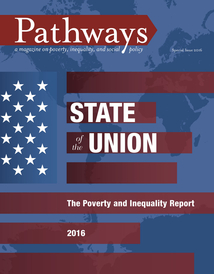State of the Union 2016

The Poverty and Inequality Report examines the “state of the union” on poverty, inequality, and labor market outcomes. The purpose of this annual report is to ensure that critical facts on poverty and inequality enjoy the same visibility as other indicators of the country’s health. This report provides a unified analysis that brings together evidence across such issues as poverty, employment, income inequality, health inequality, economic mobility, and educational access to allow for a comprehensive assessment of where the country stands.
Table of Contents (Special Issue 2016)
Summary
Is the U.S. truly an outlier when it comes to poverty and inequality outcomes? Is it instead a standard- issue “liberal regime” with outcomes that are roughly similar to those of other liberal welfare regimes? Are there particular domains in which the U.S. stands out as especially equal or unequal?
The Poverty and Inequality Report 2016
The prime-age employment rate in the U.S. still languishes well below pre-recession levels. If the current (slow) rate of improvement continues, the U.S. will likely fall into another recession before the male rate returns to its pre-recession level.
The well-known exceptionalism of American relative poverty extends only to rich countries, not to middle-income countries. Using a relative poverty standard for disposable household income, the U.S. poverty rate exceeds that reported in all of the other high-income countries in this study, with the sole exception of Israel.
The U.S. safety net provides about half of the income support needed to increase all incomes to the level needed to meet basic needs. Levels of poverty relief are typically higher—and sometimes much higher— in other post-industrial countries.
When disposable-income inequality is measured across 20–35 years of survey data, the consistent result is that the U.S. has the highest level of disposable-income inequality among rich countries. Some countries have experienced periods of falling, as well as rising, inequality over the last three decades.
Over the past four decades, only the very rich, the top 0.1 percent, have realized wealth increases in the U.S. In 2012, the top 0.1 percent included 160,000 households with total net assets of more than 20 million. At the same time, the middle class, those in the 50th-90th percentiles, have experienced a decline in their wealth share.
The income achievement gap in the United States is quite large relative to the 19 OECD countries examined here. Countries with higher levels of poverty, inequality, and economic segregation (among schools) tend to have larger income achievement gaps.
When compared to 24 middle-income and high-income countries, the U.S. ranks 16th in the amount of intergenerational earnings mobility. The relatively low level of mobility in the U.S. may arise in part because low-income children in the U.S. tend to have less stable and lower-income families, less secure families, and parents who have less time to devote to their children.
The U.S. population is not just sicker, on average, than the European population, but also has a higher level of health inequality than the European population. The U.S. states that combine low self-rated health with high health inequality look strikingly similar—in terms of their health profiles—to Central and Eastern European countries.
Segregation often overlaps with many other place-based inequalities—poverty, unemployment, crime, and housing quality and overcrowding. These overlapping disadvantages are seemingly much more common in the U.S. than in European countries, where government efforts to promote integration provide a clear contrast to the market-driven solutions preferred in the U.S.
